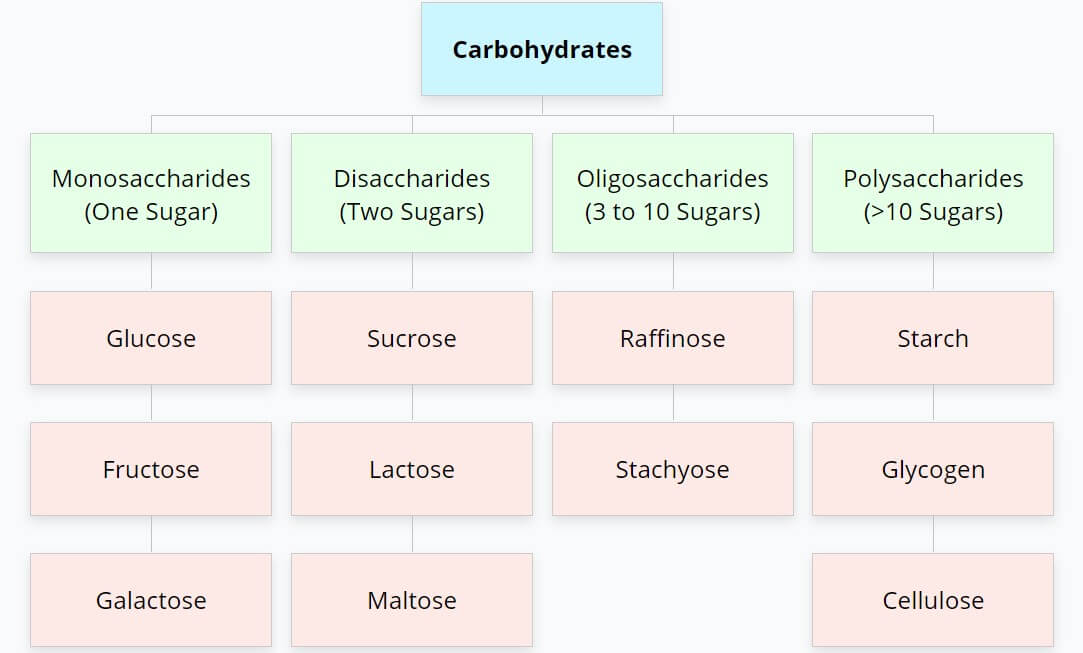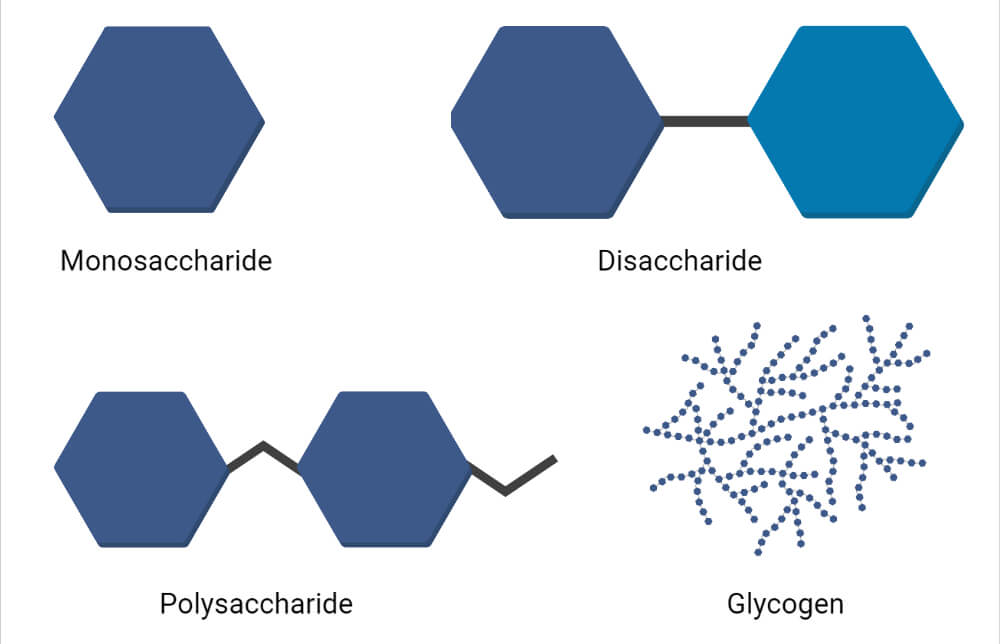Carbohydrates are a group of naturally occurring carbonyl compounds (aldehydes or ketones) that also contain several hydroxyl groups. It may also include their derivatives which produce such compounds on hydrolysis. They are the most abundant organic molecules in nature and are also referred to as “saccharides”. The carbohydrates which are soluble in water and sweet in taste are called “sugars”.
Interesting Science Videos
Structure of Carbohydrates
- Carbohydrates consist of carbon, hydrogen, and oxygen.
- The general empirical structure for carbohydrates is (CH2O)n.
- They are organic compounds organized in the form of aldehydes or ketones with multiple hydroxyl groups coming off the carbon chain.
- The building blocks of all carbohydrates are simple sugars called monosaccharides.
- A monosaccharide can be a polyhydroxy aldehyde (aldose) or a polyhydroxy ketone (ketose).
The carbohydrates can be structurally represented in any of the three forms:
- Open chain structure.
- Hemi-acetal structure.
- Haworth structure.
Open chain structure – It is the long straight-chain form of carbohydrates.
Hemi-acetal structure – Here the 1st carbon of the glucose condenses with the -OH group of the 5th carbon to form a ring structure.
Haworth structure – It is the presence of the pyranose ring structure.
Properties of Carbohydrates
Physical Properties of Carbohydrates
- Stereoisomerism – Compound shaving the same structural formula but they differ in spatial configuration. Example: Glucose has two isomers with respect to the penultimate carbon atom. They are D-glucose and L-glucose.
- Optical Activity – It is the rotation of plane-polarized light forming (+) glucose and (-) glucose.
- Diastereo isomers – It the configurational changes with regard to C2, C3, or C4 in glucose. Example: Mannose, galactose.
- Annomerism – It is the spatial configuration with respect to the first carbon atom in aldoses and the second carbon atom in ketoses.
Chemical Properties of Carbohydrates
- Osazone formation: Osazone are carbohydrate derivatives when sugars are reacted with an excess of phenylhydrazine. eg. Glucosazone
- Benedict’s test: Reducing sugars when heated in the presence of an alkali gets converted to powerful reducing species known as enediols. When Benedict’s reagent solution and reducing sugars are heated together, the solution changes its color to orange-red/ brick red.
- Oxidation: Monosaccharides are reducing sugars if their carbonyl groups oxidize to give carboxylic acids. In Benedict’s test, D-glucose is oxidized to D-gluconic acid thus, glucose is considered a reducing sugar.
- Reduction to alcohols: The C=O groups in open-chain forms of carbohydrates can be reduced to alcohols by sodium borohydride, NaBH4, or catalytic hydrogenation (H2, Ni, EtOH/H2O). The products are known as “alditols”.
Properties of Monosaccharides
- Most monosaccharides have a sweet taste (fructose is sweetest; 73% sweeter than sucrose).
- They are solids at room temperature.
- They are extremely soluble in water: – Despite their high molecular weights, the presence of large numbers of OH groups makes the monosaccharides much more water-soluble than most molecules of similar MW.
- Glucose can dissolve in minute amounts of water to make a syrup (1 g / 1 ml H2O).
Classification of Carbohydrates (Types of Carbohydrates)

The simple carbohydrates include single sugars (monosaccharides) and polymers, oligosaccharides, and polysaccharides.
Monosaccharides
- The simplest group of carbohydrates and often called simple sugars since they cannot be further hydrolyzed.
- Colorless, crystalline solids that are soluble in water and insoluble in a non-polar solvent.
- These are compound that possesses a free aldehyde or ketone group.
- The general formula is Cn(H2O)nor CnH2nOn.
- They are classified according to the number of carbon atoms they contain and also on the basis of the functional group present.
- The monosaccharides thus with 3, 4, 5, 6, 7 … carbons are called trioses, tetroses, pentoses, hexoses, heptoses, etc., and also as aldoses or ketoses depending upon whether they contain aldehyde or ketone group.
- Examples: Glucose, Fructose, Erythrulose, Ribulose.
Oligosaccharides
- Oligosaccharides are compound sugars that yield 2 to 10 molecules of the same or different monosaccharides on hydrolysis.
- The monosaccharide units are joined by glycosidic linkage.
- Based on the number of monosaccharide units, it is further classified as a disaccharide, trisaccharide, tetrasaccharide, etc.
- Oligosaccharides yielding 2 molecules of monosaccharides on hydrolysis is known as a disaccharide, and the ones yielding 3 or 4 monosaccharides are known as trisaccharides and tetrasaccharides respectively, and so on.
- The general formula of disaccharides is Cn(H2O)n-1and that of trisaccharides is Cn(H2O)n-2 and so on.
- Examples: Disaccharides include sucrose, lactose, maltose, etc.
- Trisaccharides are Raffinose, Rabinose.
Polysaccharides
- They are also called “glycans”.
- Polysaccharides contain more than 10 monosaccharide units and can be hundreds of sugar units in length.
- They yield more than 10 molecules of monosaccharides on hydrolysis.
- Polysaccharides differ from each other in the identity of their recurring monosaccharide units, in the length of their chains, in the types of bond linking units and in the degree of branching.
- They are primarily concerned with two important functions ie. Structural functions and the storage of energy.
- They are further classified depending on the type of molecules produced as a result of hydrolysis.
- They may be homopolysaccharidese, containing monosaccharides of the same type or heteropolysaccharides i.e., monosaccharides of different types.
- Examples of Homopolysaccharides are starch, glycogen, cellulose, pectin.
- Heteropolysaccharides are Hyaluronic acid, Chondroitin.

Functions of Carbohydrates
Carbohydrates are widely distributed molecules in plant and animal tissues. In plants and arthropods, carbohydrates from the skeletal structures, they also serve as food reserves in plants and animals. They are important energy sources required for various metabolic activities, the energy is derived by oxidation.
Some of their major functions include
- Living organisms use carbohydrates as accessible energy to fuel cellular reactions. They are the most abundant dietary source of energy (4kcal/gram) for all living beings.
- Carbohydrates along with being the chief energy source, in many animals, are instant sources of energy. Glucose is broken down by glycolysis/ Kreb’s cycle to yield ATP.
- Serve as energy stores, fuels, and metabolic intermediates. It is stored as glycogen in animals and starch in plants.
- Stored carbohydrates act as an energy source instead of proteins.
- They form structural and protective components, like in the cell wall of plants and microorganisms. Structural elements in the cell walls of bacteria (peptidoglycan or murein), plants (cellulose), and animals (chitin).
- Carbohydrates are intermediates in the biosynthesis of fats and proteins.
- Carbohydrates aid in the regulation of nerve tissue and is the energy source for the brain.
- Carbohydrates get associated with lipids and proteins to form surface antigens, receptor molecules, vitamins, and antibiotics.
- Formation of the structural framework of RNA and DNA (ribonucleic acid and deoxyribonucleic acid).
- They are linked to many proteins and lipids. Such linked carbohydrates are important in cell-cell communication and in interactions between cells and other elements in the cellular environment.
- In animals, they are an important constituent of connective tissues.
- Carbohydrates that are rich in fiber content help to prevent constipation.
- Also, they help in the modulation of the immune system.
References
- Lehninger, A. L., Nelson, D. L., & Cox, M. M. (2000). Lehninger principles of biochemistry. New York: Worth Publishers.
- Madigan, M. T., Martinko, J. M., Bender, K. S., Buckley, D. H., & Stahl, D. A. (2015). Brock biology of microorganisms (Fourteenth edition.). Boston: Pearson.
- Rodwell, V. W., Botham, K. M., Kennelly, P. J., Weil, P. A., & Bender, D. A. (2015). Harper’s illustrated biochemistry (30th ed.). New York, N.Y.: McGraw-Hill Education LLC.
- https://biology.tutorvista.com/biomolecules/carbohydrates.html

The information is really nice including all the points. It would be nice if you include structures of those molecules..
Well organize and knowledgeable.
Am studying this biochem in mmust am silas kiprono. Share with me some contents
OK ….Better result of your notes…thank u
Thanks 👍 best information ☺️☺️☺️
Thank you.. Nice information.. ❤️
Thanks alot, i have gained a lot of knowledge from these notes
That’s a detailed information
It’s helpful 🙂 I love it
Nice notes…. I like it too much
I love this website
Thanks alot for this note
I am biochemistry student in kasu so I need to know more about biochemistry and today I learn more from this side thank you
This site is so so good.
Absolutly beatiful notes that gave detailed explanation on the topics
Site so good…Thankyou
https://www.pharmacynotes4u.com/2019/12/carbohydrates-classification-d-pharmacy.html?m=1
Carbohydrates classification with simple words
techniques of determinig carbohydrates in urine
The sight is so fine . Thanks alot
Great site to understand indepth knowledge of Biology. I love the Bio-Chemistry subject so much and this site helps me to clear all my confusion.
Thanks A LOT!!!
Are you a biochemistry student..
Can you plz help in in the topics of bio chemistry
Yes im a biochemist student . In the case of any questions i send u a g.mail please help me in biochemistry
Sir please inform me classified carbohydrates on the basis of Composition